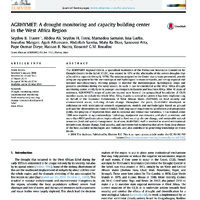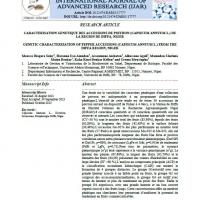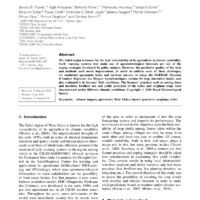Recherche
5 items
AGRHYMET: Adrought monitoring and capacity building center in the West Africa Region
The AGRHYMET Regional Center, a specialized institution of the Permanent Interstates Committee for Drought Control in the Sahel (CILSS), was created in 1974 at the aftermaths of the severe droughts that affected this region in the early 1970s. The mission assigned to the Center was to train personnel, provide adequate equipment for the meteorological and hydrological stations networks, and set up regional and national multidisciplinary working groups to monitor the meteorological, hydrological, crops and pastures conditions during the rainy season. As such, it can be considered as the West Africa drought monitoring center, similarly to its younger counterparts in Eastern and Southern Africa. After 40 years of existence, AGRHYMET’s scope of activities expend now beyond the geographical boundaries of CILSS member states, to include the whole West Africa thanks to several initiatives it has been implementing on behalf of the Economic Commission of West African States (ECOWAS) on food security and environmental issues, including climate change. Throughout the years, AGRHYMET developed, in collaboration with international research organizations, models and methodologies based on ground and satellite observations to monitor rainfall, food crop water requirements satisfaction and prospective yields, the progress of vegetation front and its seasonal and interannual variations. It has trained about 1200 new experts in agrometeorology, hydrology, equipment maintenance, and plant protection, and more than 6000 professionals on topics related to food security, climate change, and sustainable natural resources (land and water) management. As of now, AGRHYMET staff is involved in several international initiatives on climate change, food security, and environmental monitoring that allow them keep abreast of the best available technologies and methods, and also contribute to generating knowledge on those issues.
Analyse de l’évolution spatio-temporelle des dérivés pluviométriques caractérisant la saison agricole au Sahel - Central
L’objectif de cette étude est d’analyser l’évolution spatio-temporelle des dérivés pluviométriques impactant la qualité de la saison agricole, notamment les périodes de début et de fin de saison, le cumul des pluies, le nombre de jours des pluies, la longueur de la saison et les séquences sèches. Elle s’appuie sur l’analyse des données journalières de 1951 à 2010 de 98 stations météorologiques. Les dérivés pluviométriques sont
d’abord identifiés, ensuite, des indices adaptés sont utilisés pour caractériser leurs évolutions. Ces dérivés présentent des fortes variabilités spatiales et temporelles. Cela a permis de subdiviser la région en quatre (4) zones avec des caractéristiques moyennes très distinctes.
Caractérisation génétique des accessions de poivron (Capsicum Annum L.) de la Région de Diffa, Niger
Une étude sur la variabilité des caractères génétiques d'une collection de poivron est indispensable à un programme d'amélioration génétique. L’objectif de cette étude est de tester 30 accessions de poivron suivant un dispositif de Fisher à 4 blocs, à la Station de Diffa de l'Institut National de la Recherche Agronomique du Niger (INRAN).6 caractères qualitatifs et 16 caractères quantitatifs ont été observés et mesurés. Les caractères qui traduisent une grande variation (CV>30 %) sont le nombre total des fruits (83,98%), le poids des fruits (62,86%), la longueur des fruits (42,48%) et la surface foliaire (30,48%). L’accession Go-027 a été plus performante en nombre total des fruits (57 fruits) et quant aux accessions Ma-032 et Ma-033, elles ont été plus performantes pour la longueur des fruits. Une forte et positive corrélation existe entre plusieurs caractères dont phénologiques (Dat50Fl et Dat1Fr, p=080), de croissance (LgFe et Srfo, p=0,93)et de rendement (PdFr et LgFr, p=0,72).Pour tous les paramètres, la variance phénotypique (σ2p) était supérieure à la variance génotypique (σ2g). La hauteur des plantes (67,66%), la largeur des fruits (65,76%) et le diamètre des fruits (64,09) présentent des valeurs d'héritabilité au sens large élevées (H2 ˃60 %).L’analyse en composante principale (ACP) et la classification ascendante hiérarchique (CAH) ont montré la formation de 4 groupes distinctes. Le groupe G1esttardif avec une grande hauteur associé à un faible poids en fruits, le groupe G2 est composé des accessions intermédiaires, le groupe G3 est tardif avec moins de hauteur et plus de rendement en poids des fruits. Enfin le groupe G4 est précoce, avec une grande hauteur et un bon couvert végétal associé a des fruits longs. Cette caractérisation offre un matériel génétique aux chercheurs leur permettant d’améliorer le potentiel de rendement en fruits commercialisables.
Characterizing and modeling the diversity of cropping situations under climatic constraints in west africa
The Sahel region is known for the high vulnerability of its agriculture to climate variability. Early warning systems that make use of agrometerological forecasts are one of the coping strategies developed by policy makers. However, the predictive quality of the tools and methods used needs improvement. In order to address some of these challenges, we conducted agronomic trials and on-farm surveys to adapt the SARRAH (Syst`eme d’Analyse R´egionale des Risques Agroclimatiques, version H) crop simulation model, and also evaluated it in farmers’ field conditions. The farmers’ practices such as sowing dates and densities, fertilizer use and yields potentials of the millet and sorghum crops were characterized under different climatic conditions.
Estimates of Phenotypic and Genotypic Variance and Heritability in Eighty Nine Bambara Groundnut Vigna subterranea (L.) Verdcourt] Accessions Collected from Six Regions of Niger
The bambara groundnut [Vigna subterranea (L.) Verdc. (Fabaceae)] is a legume mainly cultivated by women, for the nutritional quality of these seeds. It is a so-called minor culture and the improvement of the plant and its popularization remains to be promoted. The objective of this present work is to evaluate the genetic variability of bambara groundnut accessions. The experiment was carried out according to a completely randomized block device with four replications. Twenty-two (22) characters including four (4) phenological, four (4) morphological and fourteen (14) related to yield were evaluated for accessions characterization. Descriptive analysis showed significant differences. The coefficients of variation ranged from 3.51% (maturity date) to 38.87% (shell weight). Significantly high values (CV˃20%) for 8 of the metric parameters were observed. Pod weight per plant and seed weight per plant (r=0.943), yield in kg/ha (r=0.943); seed weight per plant and yield in kg/ha (r=0.999) showed the strongest correlations. The phenotypic and genotypic coefficients of variation were high for dry biomass weight (PCV=42.23%; GCV=28.40%), shell weight (PCV=63.46%; GCV=22.46%) and 100-seed weight (PCV=25.57%; GCV=25.25%). Maturity date (95.77%) and 100-seed weight (99.84%) had high heritabilities. Broad-sense heritability and genetic gain are high for 100-seed weight (H2=99.84%; GA=52.58%). The Ascending hierarchical classification produced four groups of which group 4 is the most efficient in yield with short (20.58cm) early accessions (80.32 days). Groups 1 and 2 include, late accessions (~22cm) with respectively maturity dates (DM=85.67 days and DM=86.53 days.



